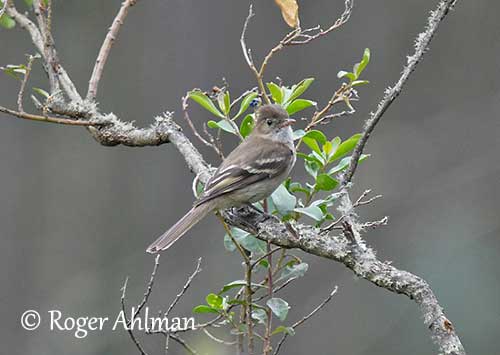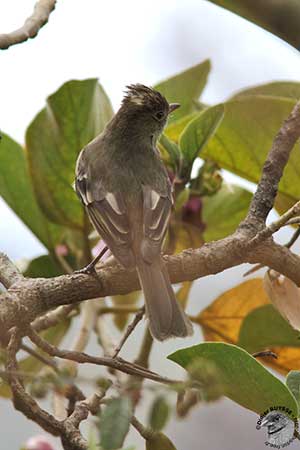
Fr: Elénie à cimier blanc
Ang: White-crested Elaenia
All: Weißbauch-Olivtyrann
Esp: Fiofío Crestiblanco
Ita: Elenia crestabianca
Nd: Witkuifelenia
Sd: Vittofsad elenia
Photographers:
Roger Ahlman
Pbase Galleries Peru and Ecuador & My bird pictures on IBC
Didier Buysse
Vision d’Oiseaux
Eduardo Andrés Jordan
MIS AVES – AVES DE ARGENTINA
Texte de Nicole Bouglouan
Sources:
HANDBOOK OF THE BIRDS OF THE WORLD Vol 9 - by Josep del Hoyo - Andrew Elliot - David Christie - Lynx Edicions - ISBN: 8487334695
A GUIDE TO THE BIRDS OF COLOMBIA by Steven L. Hilty and William L. Brown - Princeton University Press – ISBN 069108372X
BIRDS OF PERU by Thomas S. Schulenberg, Douglas F. Stotz, Daniel F. Lane, John P. O’Neill, Theodore A. Parker III – Princeton University Press 2007-ISBN: 978-0-691-13023-1
BIRDS OF SOUTH AMERICA – Passerines - by Robert S. Ridgely and Guy Tudor – HELM Field Guides – ISBN: 9781408113424
Neotropical Birds – Cornell Lab of Ornithology
Arthur Grosset's Birds (Arthur Grosset)
Birding Patagonia – Adventure expeditions
South Dakota Birds and Birding – (Terry L. Sohl)
Wikipedia, the free encyclopaedia
White-crested Elaenia
Elaenia albiceps
Passeriformes Order – Tyrannidae Family
INTRODUCTION:
The White-crested Elaenia is a member of the subfamily Elaeniinae within the large family Tyrannidae. Several subspecies share the wide range across South America.
It frequents subtropical or tropical humid montane forests and high-altitude shrubland where it feeds on small fruit, berries and insects. It is usually solitary, but outside the breeding season, they can be seen in flocks of up to 100 individuals, including during the migrations of the southern races.
The White-crested Elaenia is relatively common throughout its range, and the species is not currently threatened.

DESCRIPTION OF THE BIRD:
Biometrics:
Length: 14-15 cm
Weight: 12-25 g
The White-crested Elaenia adult of nominate race has uniform, dark olive-grey crown and upperparts. The coronal patch is whitish and the face is slightly paler than the upperparts. We can see a pale, narrow eyering and whitish lores.
Wings and tail are darker. On the upperwing, there are two yellowish-white wingbars and the flight-feathers have whitish edges.
On the underparts, chin and throat are pale greyish, the breast is mostly greyish-brown whereas the belly is whitish.
The bill is black with paler base on lower mandible. The eyes are dark brown. Legs and feet are black.
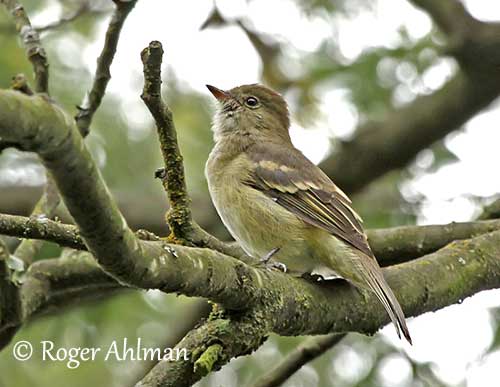
Male and female have similar plumage, but the male is larger, especially with longer wings and tail.
The juvenile has less distinct yellower wingbars than adults. On the head, the coronal patch is reduced or absent.
SUBSPECIES AND RANGE:
The White-crested Elaenia has six subspecies. The race E.a. chilensis is often considered a full species by some authors.
E.a. griseigularis is found in SW Colombia, S to NW Peru (S to W Cajamarca).
This race has paler upperparts. The crest is shorter and less white. The eyering is less visible than on nominate.
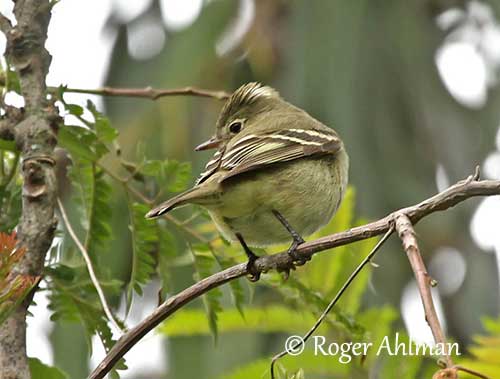
E.a. diversa occurs in the Andes of NC Peru (Cajamarcas S to Huánuco).
This one resembles previous but is has white throat, less distinct wingbars, olive flanks and white belly, and larger coronal patch.
E.a. urubambae is found in NE Peru (near Cuzco).
This race is paler and duller than nominate, and it has slightly heavier bill.
E.a. albiceps (described above) is found in SE Peru (S from Puno) and S to NW Bolivia.
E.a. modesta occurs in W Peru, S to NW Chile.
This one is paler and duller overall, and the grey crown has speckled appearance.
E.a. chilensis breeds in the Andes from S Bolivia, S to Argentina, and thence, S in lowlands to Tierra del Fuego. It migrates N as far as Peru and possibly Colombia, and NE Brazil.
This race has dark olive upperparts, conspicuous whitish lores and eyering, and pure white coronal patch. The pale wingbars are narrow and sharply defined. On the underparts, throat and breast are pale olive-grey, belly is white and flanks are olive, whereas the undertail-coverts are yellow.
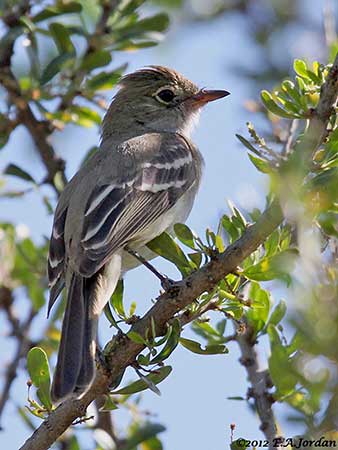
HABITAT:
The White-crested Elaenia frequents a wide variety of wooded habitats such as forest edge, secondary growth and semi-humid scrub. It breeds in drier valleys.
The race “chilensis” is found in a variety of habitats where tall scrub and trees are present.
During the austral winter, it favours open woodland, low shrubbery, clearings and elfin forest. The species occurs from sea-level up to 3,300 metres of elevation.
CALLS AND SONGS: SOUNDS BY XENO-CANTO
The White-crested Elaenia is very vocal during the breeding season. It utters continuously a trilled “feeur” or “feeo”. It sings at dawn, a typical “breeyr, breeyr-it”. The calls include an abrupt “peeyr” and a trilled “brreeo”.
BEHAVIOUR IN THE WILD:
The White-crested Elaenia consumes regularly small fruit and berries outside the breeding season, and small insects. It may take nectar from silky oak Grevillea robusta.
It feeds from perch and sallies, or by hovering in front of the vegetation. It is often seen alone, but they may gather in flocks at food sources such as flowering and fruiting trees. This species is an important pollinator for flowering trees.
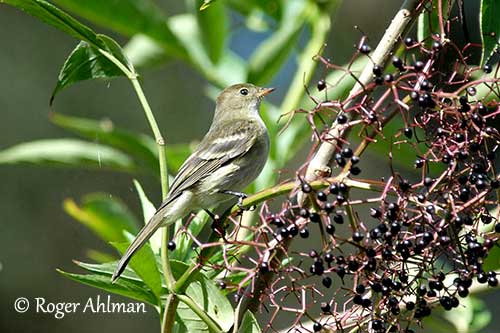
The breeding behaviour is poorly known. They are monogamous and solitary nesters. The pair defends the territory.
During the displays, both courtship and threat, the coronal patch becomes more conspicuous while the short crest is erected. They also spread, fan and flutter their wings while singing.
The White-crested Elaenia is resident in the northern part of the range, although altitudinal movements probably occur after breeding.
The southern birds such as the race “chilensis” are highly migratory and spend the austral winter in Central South America and Amazon Basin. Vagrants are recorded in Falkland Islands and between South American mainland and South Shetland Islands.
The White-crested Elaenia is a good flier.
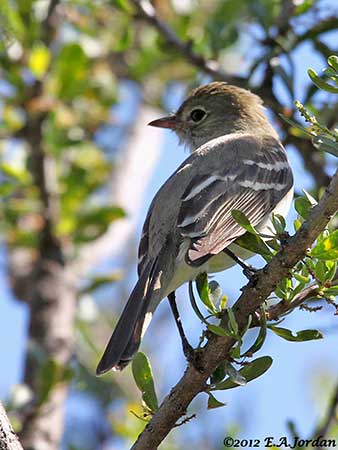
REPRODUCTION OF THIS SPECIES:
The breeding season takes place between November and January (race chilensis) and probably December to January/February (race modesta).
The nest is a small cup made with grasses, leaves, mosses or lichens and small twigs. The cup is lined inside with feathers or plant down. The nest is placed in a fork, in tree or shrub. One nest was reported from a cavity.
The female lays 2-3 creamy-white eggs with some red spots. Incubation and fledging periods are unknown.
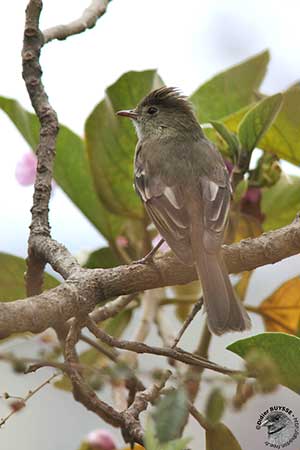
PROTECTION / THREATS / STATUS:
The White-crested Elaenia is common to locally abundant throughout the wide range, but it seems to be less common in the northern part of the range. This species is tolerant of converted habitats and is present in numerous protected areas.
The population size is unknown but it appears to be stable.
The White-crested Elaenia is currently evaluated as Least Concern.
